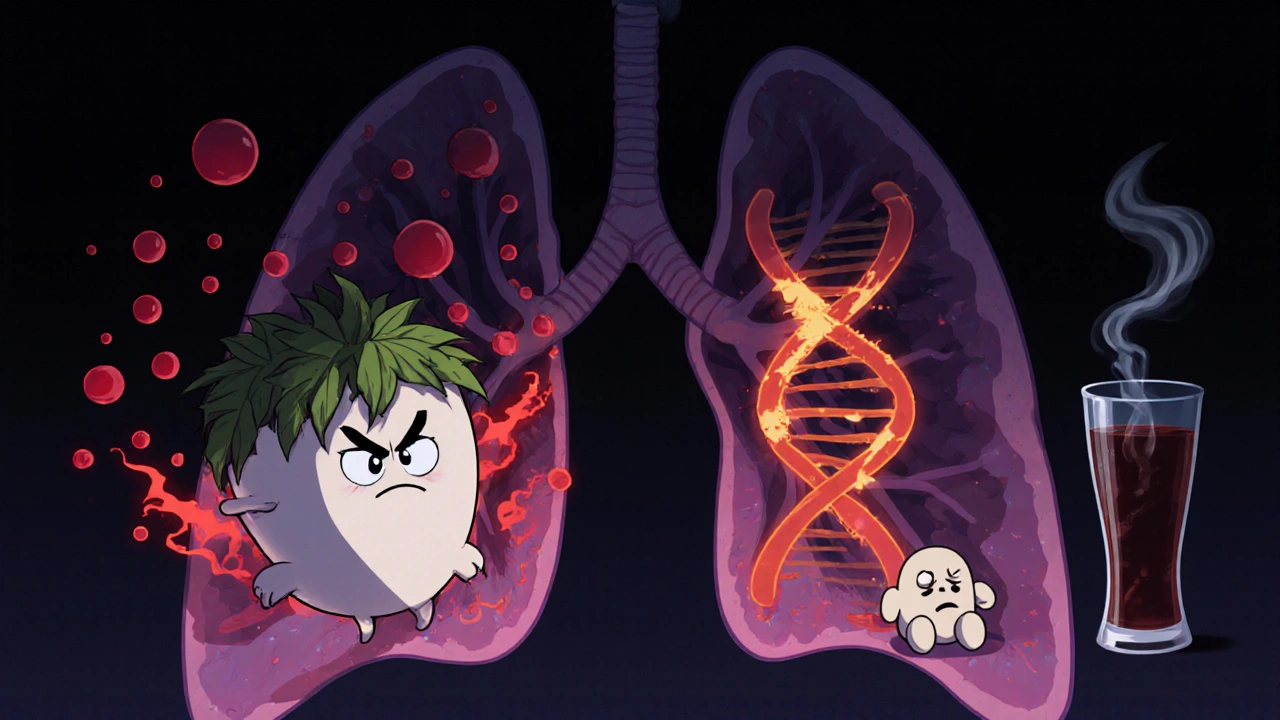When you hear the word “enzyme,” you probably think of digestion or a lab test. In reality, enzymes are the body’s tiny workhorses, driving reactions that keep cells healthy and stop them from turning cancerous. If those workhorses stall, the odds of cancer rise dramatically.
Key Takeaways
- Enzymes regulate antioxidant defense, DNA repair, and toxin clearance - three pillars of cancer prevention.
- A shortage of specific enzymes, known as enzyme deficiency, weakens these pillars and fuels tumor growth.
- Diet, lifestyle, and certain medications can boost protective enzymes or, conversely, deplete them.
- Monitoring enzyme activity offers early warning signs and can guide personalized prevention strategies.
What Is an Enzyme?
Enzyme is a biological catalyst that accelerates chemical reactions in living organisms without being consumed. Enzymes lower the activation energy required for biochemical pathways, allowing processes like metabolism, DNA repair, and detoxification to occur swiftly and efficiently.
How Enzymes Guard Against Cancer
Enzymes protect cells in three main ways:
- Neutralizing Reactive Oxygen Species (ROS) - Antioxidant enzymes such as superoxide dismutase (SOD), catalase, and glutathione peroxidase convert harmful free radicals into water and oxygen, preventing DNA damage that can trigger mutations.
- Repairing DNA Damage - DNA repair enzymes like poly (ADP‑ribose) polymerase (PARP) and DNA ligase scan for breaks, restore correct sequences, and signal cells to undergo apoptosis if damage is irreparable.
- Detoxifying Carcinogens - Metabolic enzymes, particularly the cytochrome P450 family, metabolize environmental toxins and endogenous by‑products, turning them into harmless compounds that can be excreted.
When any of these systems falter, damaged cells survive and multiply, laying the groundwork for malignancy.

Enzyme Deficiencies Linked to Higher Cancer Risk
Research from the National Cancer Institute (2024) highlights several enzyme shortfalls that correlate with specific cancers:
- Low SOD activity - Associated with increased risk of lung, breast, and colorectal cancers due to unchecked oxidative stress.
- Reduced glutathione peroxidase - Observed in prostate cancer patients; the enzyme’s inability to clear lipid peroxides fuels tumor proliferation.
- PARP1 deficiency - Leads to accumulation of DNA double‑strand breaks, raising susceptibility to ovarian and pancreatic cancers.
- Cytochrome P450 1A1 (CYP1A1) polymorphisms - Impair detoxification of polycyclic aromatic hydrocarbons, which are prevalent in tobacco smoke and grilled meats.
These deficiencies can be inherited, arise from chronic exposure to pollutants, or develop with age.
Lifestyle Factors That Influence Enzyme Levels
Many everyday choices either nurture or drain enzyme activity:
- Nutrition - Foods rich in selenium (Brazil nuts), zinc (pumpkin seeds), and vitamin C (citrus) are co‑factors for antioxidant enzymes.
- Physical activity - Regular aerobic exercise upregulates SOD and catalase in muscle tissue, enhancing systemic antioxidant capacity.
- Alcohol and smoking - Both generate excess ROS and can inhibit CYP450 enzymes, creating a double hit.
- Medications - Certain antibiotics and NSAIDs temporarily suppress gut microbiota, which in turn reduces microbial enzyme production that supports host detox pathways.
Comparing Enzyme Groups for Cancer Prevention
| Enzyme Category | Primary Function | Representative Enzymes | Cancer‑Protective Role | Effect of Deficiency |
|---|---|---|---|---|
| Antioxidant Enzymes | Scavenge reactive oxygen species | Superoxide Dismutase (SOD), Catalase, Glutathione Peroxidase | Prevent DNA oxidation and mutation | Elevated oxidative stress → higher mutation rate |
| DNA Repair Enzymes | Identify and fix DNA lesions | PARP1, DNA Ligase IV, ATM Kinase | Eliminate pre‑cancerous cells or trigger apoptosis | Accumulation of unrepaired breaks → chromosomal instability |
| Metabolic Detox Enzymes | Convert carcinogens to excretable forms | Cytochrome P450 1A1, Glutathione S‑Transferase (GST) | Reduce internal exposure to mutagens | Persistent carcinogen buildup → chronic DNA damage |

Boosting Protective Enzyme Activity
Here are evidence‑backed ways to keep those critical enzymes humming:
- Eat a colorful plate - Phytochemicals like sulforaphane (broccoli) and curcumin (turmeric) activate the Nrf2 pathway, which ramps up production of SOD, catalase, and GST.
- Maintain adequate micronutrients - Selenium (55 µg/day) supports glutathione peroxidase; zinc (8‑11 mg/day) is essential for DNA‑binding enzymes.
- Exercise regularly - A meta‑analysis (2023) showed that 150 minutes of moderate aerobic activity per week increased circulating SOD activity by 15‑20%.
- Limit alcohol and tobacco - Cutting these reduces ROS formation and preserves CYP450 functionality.
- Consider targeted supplements - N‑acetylcysteine (NAC) replenishes glutathione stores, but only under medical supervision.
Personalized testing-such as measuring plasma SOD activity or assessing GST genotype-can guide which interventions will be most effective for you.
Warning Signs of Low Enzyme Activity
While you won’t feel a “enzyme deficiency” like you might feel a vitamin lack, certain symptoms can hint at compromised enzyme defenses:
- Chronic fatigue despite adequate sleep - often linked to oxidative stress overload.
- Frequent infections - may indicate impaired detox pathways.
- Unexplained skin changes (hyperpigmentation, premature aging) - oxidative damage manifesting externally.
- Elevated inflammatory markers (CRP, IL‑6) - inflammation can suppress antioxidant enzyme expression.
If you notice these, discussing enzyme panel testing with a healthcare professional is a prudent step.
Frequently Asked Questions
Can I boost my enzyme levels with diet alone?
Yes, many foods contain compounds that activate key enzymes. Cruciferous vegetables, berries, nuts, and spices like turmeric supply the nutrients and phytochemicals needed for antioxidant and detox enzymes to work optimally.
Is there a genetic test for enzyme deficiencies?
Genetic panels can identify polymorphisms in genes such as CYP1A1, GSTM1, and SOD2. These variants predict how efficiently your body processes toxins and oxidative stress, helping physicians tailor prevention strategies.
Do supplements like NAC or vitamin C replace the need for enzymes?
Supplements can support enzyme function-NAC replenishes glutathione, and vitamin C scavenges free radicals-but they cannot substitute for the catalytic activity of enzymes. Think of them as helpers, not replacements.
How often should I have my enzyme levels checked?
For most healthy adults, routine checks aren’t required. If you have a family history of cancer, chronic exposure to toxins, or symptoms of oxidative stress, a yearly panel ordered by your doctor is reasonable.
Can low enzyme activity cause cancer on its own?
Enzyme deficiency is usually one piece of a larger puzzle. It creates a permissive environment for DNA damage, but additional factors-like genetic mutations, lifestyle, and immune status-determine whether cancer actually develops.
Understanding the silent but powerful role of enzymes opens a practical path to cancer prevention. By watching your diet, staying active, and, when needed, checking enzyme function, you can keep those cellular workhorses turning the gears that keep tumors at bay.







